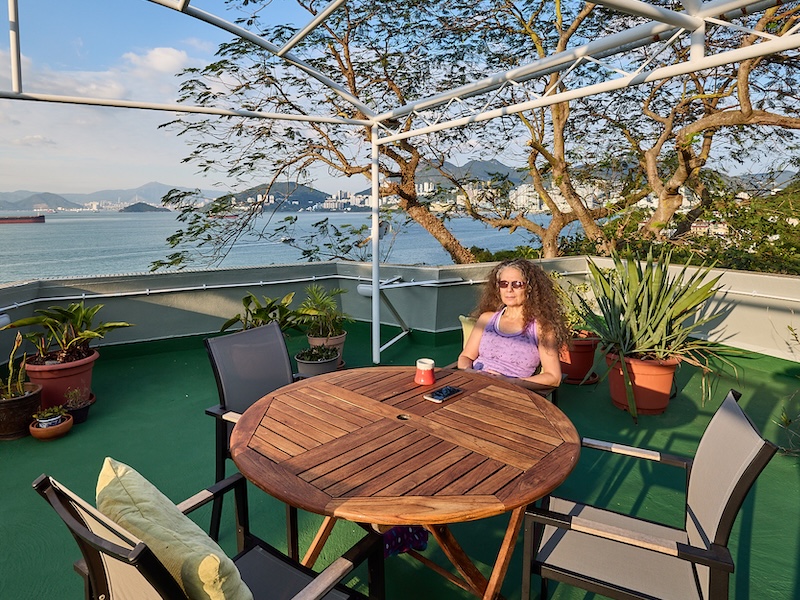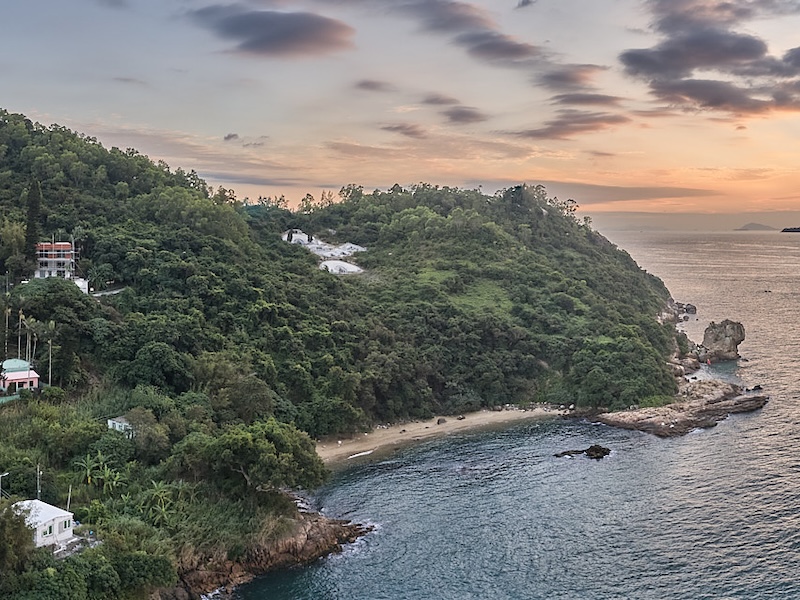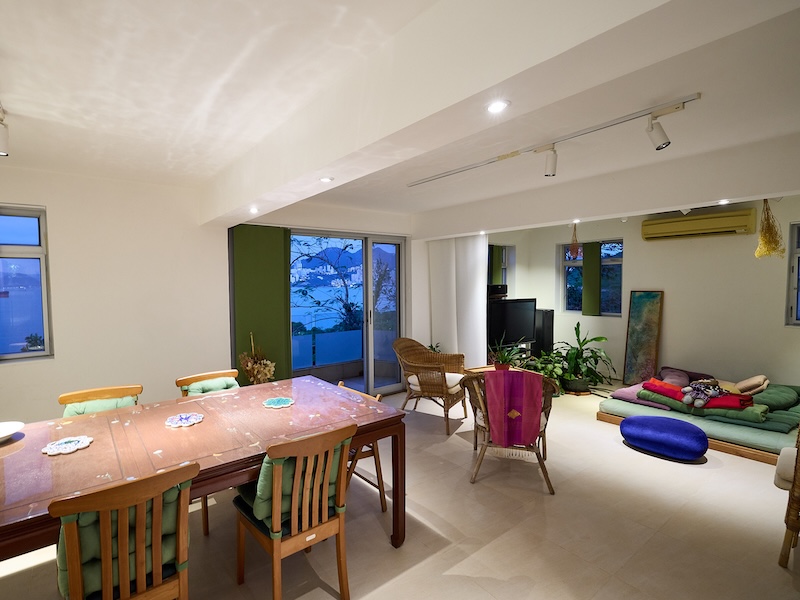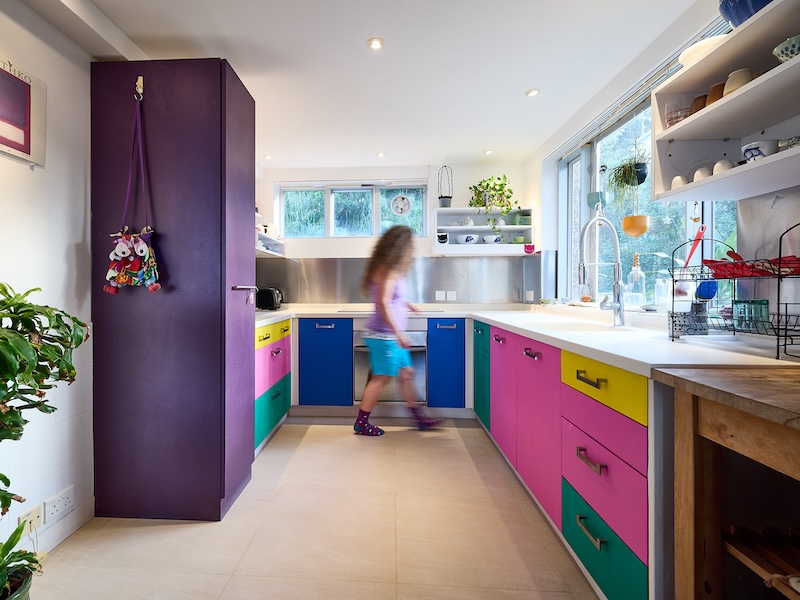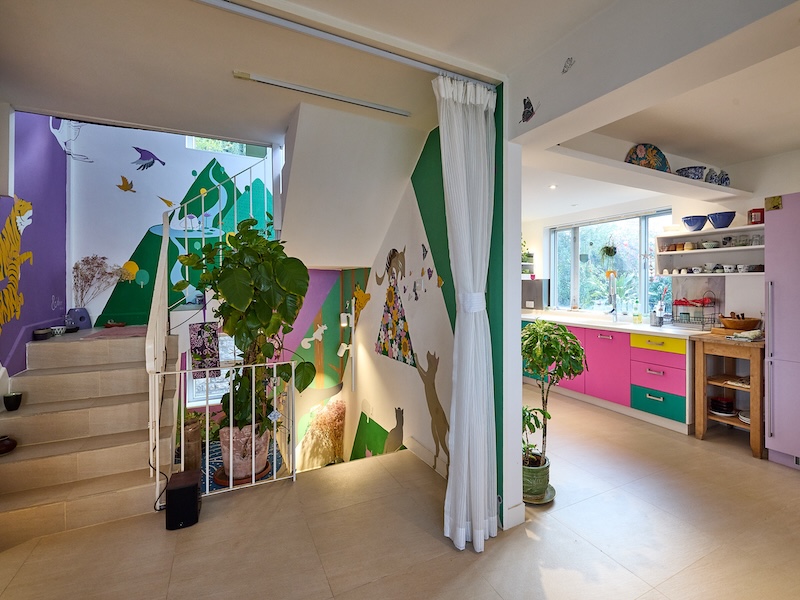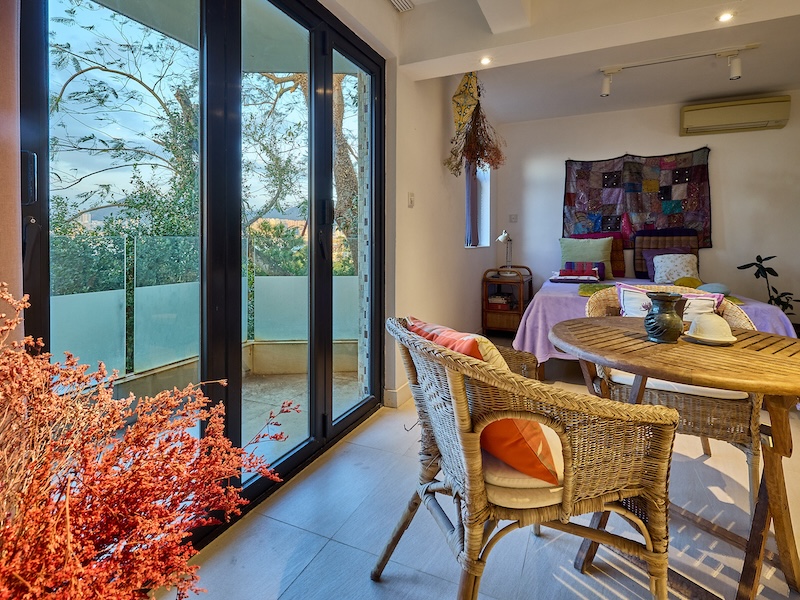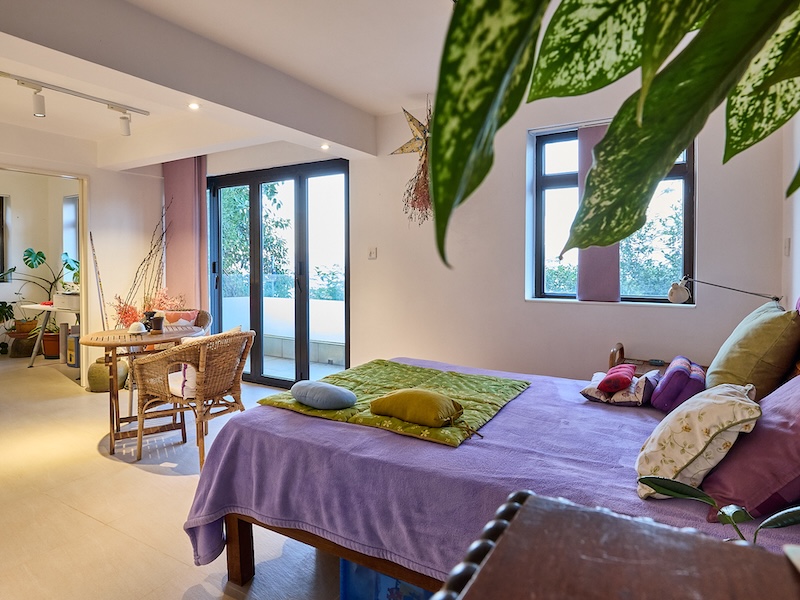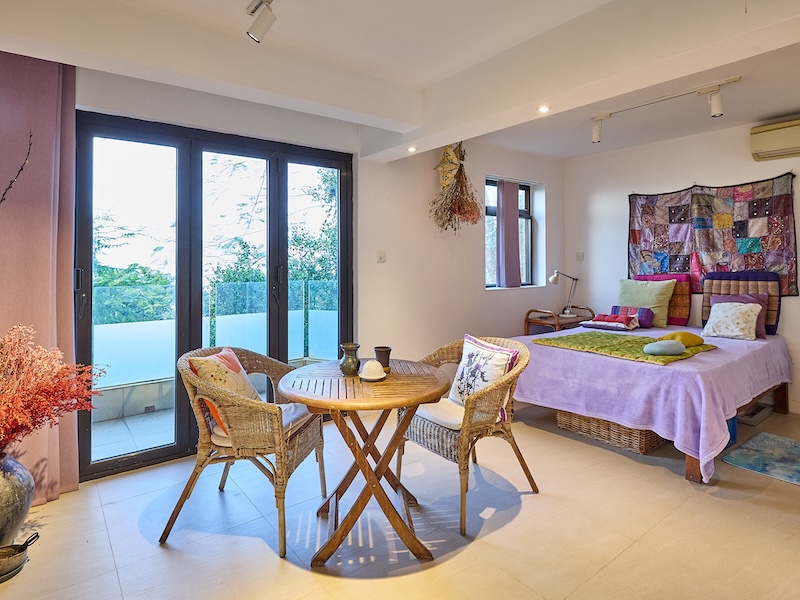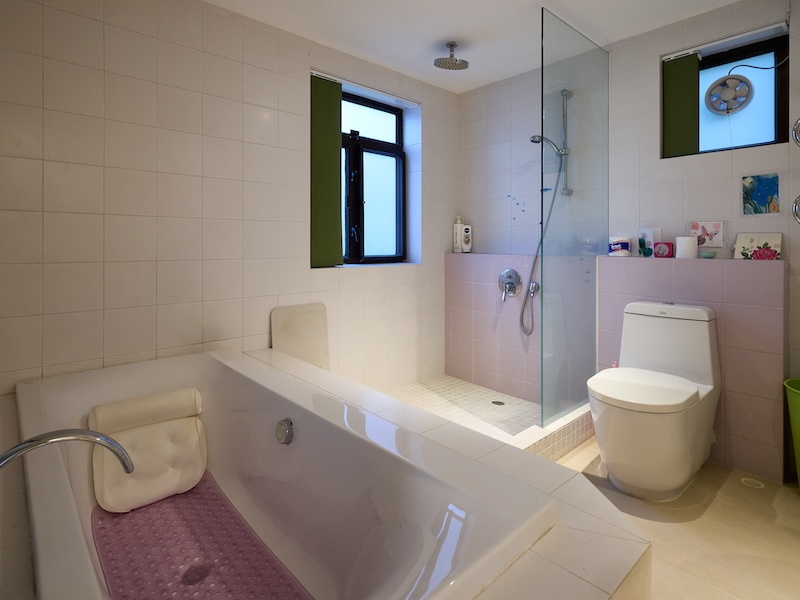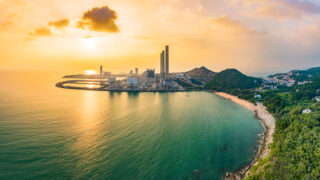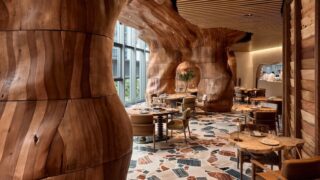LOWANA PHILLIPS has lived in this Lamma Island house for well over 20 years – and the unique duplex in Pak Kok Kau Tsuen on the northern end of the island is currently on the market! We went along for a look and a tour of this house for sale in Hong Kong.
Tell us about yourself and your move to Hong Kong – and more specifically to Lamma.
I was born in Canberra, Australia, and then moved to Scotland. I came to Hong Kong in 1998 after living in Italy and in Prague in the Czech Republic. Since 2003, I’ve been working at the University of Hong Kong, where I’m a lecturer at the Centre for Applied English Studies. I wanted to have an island life rather than a city life because I grew up in the countryside in Scotland. After visiting Lamma, I rented a flat in Yung Shue Wan (the main village), then moved to Pak Kok in 2001 because it’s such a lovely village to live in. When I bought my flats I used my undergraduate training in Fine Art to develop them into a work of art for living in, surrounded by the greater art of nature.
What’s life in Pak Kok like?
It’s a unique experience to live in a quiet village community within half an hour from a busy international hub like Hong Kong. You can switch off from the intensity of HK when you get on the ferry and enjoy a peaceful journey home bobbing up and down on the water, watching beautiful sunsets.
Describe the location of your home.
My flats overlook Pak Kok village, with mountains behind and the ocean out front. My home has been described as like being at the opera because you can sit on the roof and contemplate the sea and the panoramaof mountains and islands. The atmosphere is quiet and also dynamic. There’s always something to see on the sea, in the sky, or in the trees that surround the flat. There are butterflies and interesting birds hovering, and beautiful flowers – it’s a wonderful, idyllic way to enjoy nature. The village shop and local ferry pier are less than a five-minute walk away.
What’s the layout of your Lamma Island house?
The house is a duplex of the middle and top floor of a three-storey house, plus a private roof. The first and the second floor and the whole of the roof are each 700 square feet in size.
How long did the renovation work take, and what did it involve?
The initial work took about two months. I bought two floors (the middle and top floor) of a three-floor house in 2008. I combined the two floors into a duplex and renovated most of the interior and the roof. Along with putting in new plumbing and electricity, I linked the two floors with an internal staircase. On the roof, I removed an old water tank that wasn’t needed anymore, creating more space. I also waterproofed the roof and added side and overhead lighting. Plus I added a canopy for shade; it enlarges the usable area of the flat, and keeps the indoor space cool in the summer. The balconies are glass panels so you have an infinite horizon out to the ocean. I also put in an extra guest bathroom, so there are three bathrooms.
Everything inside was worked on with an interior design company. We spent a lot of time thinking about how to create flexible space. There are different ways to configure areas for sleeping, entertaining or studying, for example. The colour scheme is purple, yellow, pink, green and blue. There is track lighting, rain showers, a round shower and a step-in bath. Japanese-style sliding panels, made by a specialist firm, and a sliding wall between the master bedroom and study allow for flexible use of space. I also installed tailored window blinds that are minimal and flexible.
I spent a long time colour-coordinating as my background is in visual literacy. You’ll see a lot of purple and pink, my favourite colours. I have a pink Siemens built-in fridge and a purple larder, for example. Purple is neither too warm nor too cool, and complements many other colours. It’s opposite yellow on the colour wheel, so it has a nice partner to work with. You can add yellow highlights, like little bits of sunshine.
Tell us about your striking mural.
I commissioned a company to create a mural connecting the two floors and the roof. The three-level internal mural moves from the ocean through the forest up into the air as you walk up the stairs and has many different species of animals featured with names next to them. It’s full of movement and different perspectives, and is also an educational piece, showing how animals live and co-exist.
The master bathroom is another key feature, right?
Yes, I spent a long time with the design company creating a flow of space because I wanted to have a biggish bath that was accessible from the rain shower. We put steps between the bath and shower. The bath is on a slightly higher level so there are steps down to the shower providing a continuation of different levels. I’ve always liked the idea of having different ways of moving around space because I’m interested in interior design and architecture.
What do you like most about your home?
Aside from my circular purple “power shower”, I would say the roof, because you can become hypnotised by the sky, the sea, the birds and nature. It’s wonderful to be close to eagles flying overhead. And when the flame tree comes out with butterflies flitting around and beautiful bird song, it’s like nature’s orchestra of colour and sound. My large, open-plan, colourful kitchen is really fun to cook in. All the doors are different colours, and there is a wonderful view of trees outside.
Sitting in the lounge and taking in the green views, there’s nothing behind you and nothing in front of you, with cooling breezes from all sides.
Who do you envisage buying your Pak Kok house?
Someone who likes the peace and quiet of a rural area while being within a 30-minute ferry ride of one of the world’s great cities. A family could happily live here, with the different areas for kids to play and study, and multiple ways to have different family interactions. The dining area connects to both the kitchen and the living area, so it’s great for entertaining. You’ve also got French windows opening out onto the sea and panoramic views. And, of course, there’s the roof, which would be ideal for a yoga enthusiast, or someone interested in growing plants. The canopy provides a lovely shaded area when it’s hot.
Any drawbacks to living on this side of Lamma Island?
There’s only one little shop in our village, so you have to be organised. If you do want to get things delivered, you can use the daily cargo boat that comes from Kennedy Town on HK Island. The boat goes to the nearby pier and then you can hire a “VV” (village vehicle) to get things to your home.
The last ferry from Aberdeen, on the south of HK Island, to Pak Kok pier is 10pm and takes 25 minutes. You can also get a 30-minute ferry from Central, on the north of HK Island, to Yung Shue Wan, the main village on Lamma. The path from Yung Shue Wan to Pak Kok provides a truly amazing walk with wonderful coastal and city views.
Find out more about this Lamma Island house for sale in Hong Kong:
The sale price is $10 million; contact Lowana at WhatsApp 6017 7264 or lowanaphillips@hotmail.com.
Liked this article about a Lamma Island house for sale in Hong Kong? It first appeared in the Winter 2024/2025 issue of Expat Living magazine. Subscribe now so you never miss an issue!
Find more style inspiration in ourHome section.

